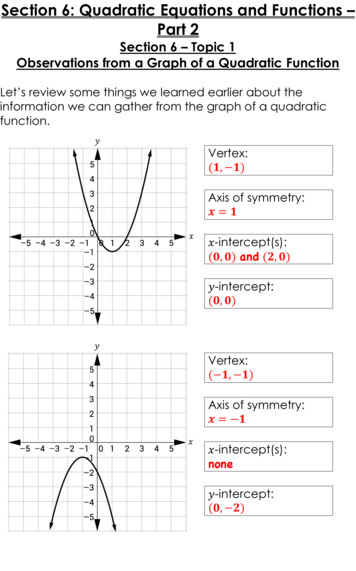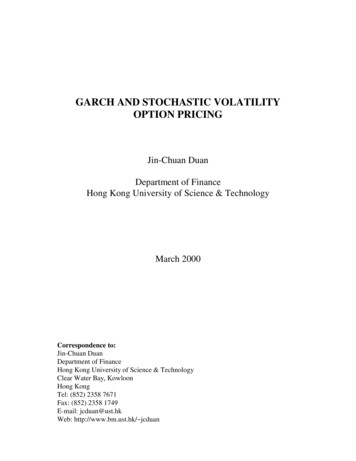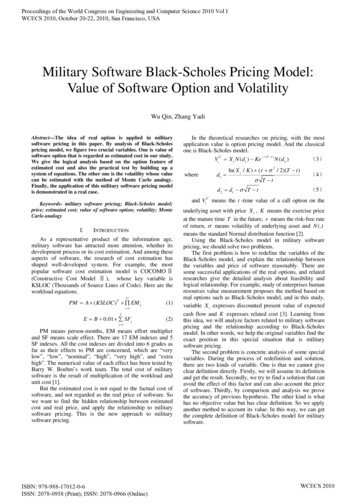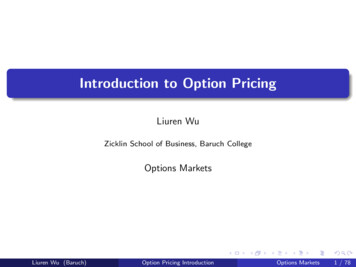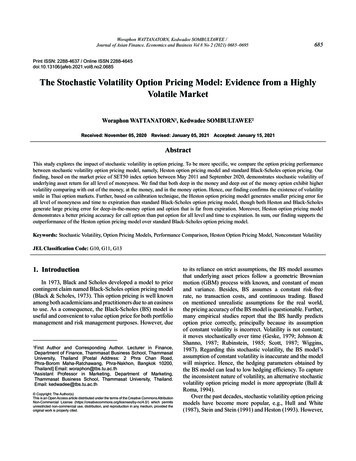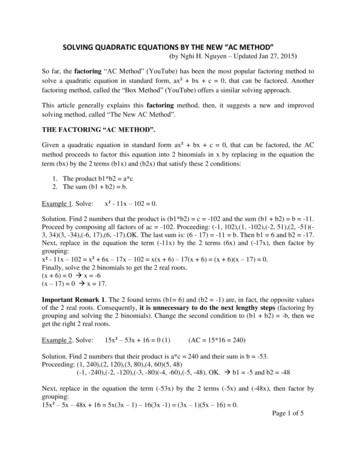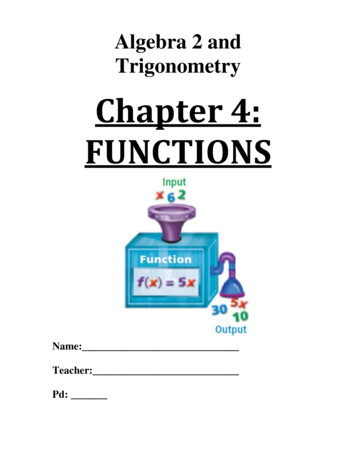
Transcription
Journal of Mathematical Finance, 2012, 2, 159-174http://dx.doi.org/10.4236/jmf.2012.22017 Published Online May 2012 (http://www.SciRP.org/journal/jmf)Option Pricing Applications of Quadratic Volatility ModelsSrimantoorao S. Appadoo1*, Aerambamoorthy Thavaneswaran2, Saman Muthukumarana21Department of Supply Chain Management, University of Manitoba, Winnipeg, Canada2Department of Statistics, University of Manitoba, Winnipeg, CanadaEmail: *appadoo@cc.umanitoba.caReceived January 20, 2012; revised March 1, 2012; accepted March 16, 2012ABSTRACTRecently there has been a surge of interest in higher order moment properties of time varying volatility models. VariousGARCH-type models have been developed and successfully applied in empirical finance. Moment properties are important because the existence of moments permit verification of how well theoretical models match stylized facts suchas fat tails in most financial data. In this paper, we consider various types of random coefficient autoregressive (RCA)models with quadratic generalized autoregressive conditional heteroscedasticity (GARCH) errors and study the moments, mean, variance and kurtosis. We also consider the Black-Scholes model with RCA GARCH volatility and showthat these moments can be used to evaluate the call price for European options.Keywords: Garch Processes; RCA Models; Garch Models; Time Varying Volatility; Kurtosis1. IntroductionIt is well-known that many financial time series such asstock returns exhibit leptokurtosis and time-varying volatility [1]. The generalized autoregressive conditional heteroscedasticity (GARCH) and the random coefficientautoregressive (RCA) models have been extensively usedto capture the time-varying behaviour of the volatility.Studies using GARCH models commonly assume thatthe time series is conditionally normally distributed; however, the kurtosis implied by the normal GARCH tendsto be lower than the sample kurtosis observed in manytime series Bollerslev [1]. Thavaneswaran et al. [2] usean ARMA representation to derive the kurtosis of variousclasses of GARCH models such as power GARCH, nonGaussian GARCH, non-stationary and random coefficient GARCH. Recently, Thavaneswaran et al. [3], Appadoo et al. [4] have extended the results to stationaryRCA processes with GARCH errors and Paseka et al. [5]further extended the results to RCA processes with stochastic volatility (SV) errors.Leptokurtosis is commonly observed in financial timeseries, as well as in currency and commodity markets.The opening and closure of the markets, time-of-the-dayand day-of-the-week effects, weekends and vacation periods cause changes in the trading volume that translatesinto regular changes in price variability. Financial, currency, and commodity data also respond to new information entering into the market, which usually have largekurtosis. Recently, there has been growing interest in*Corresponding author.Copyright 2012 SciRes.using volatility models [3,4]. Most of the studies useGARCH models with dummy variables in the volatilityequation, and a few of them have been extended to amore flexible form such as the RCA GARCH. However,even though much research has been performed on volatility models applied to market data such as stock returns,more general specifications accounting for RCA withGARCH errors have been little explored. First we derivethe kurtosis of a simple time series model with behaviourin the mean. Then we introduce various classes of RCAGARCH models and study the moments and discuss applications in option pricing. We extend the results forRCA GARCH volatility models to RCA quadratic GARCHmodels. The RCA GARCH model is appropriate for timeseries where significant autocorrelation exists. Optionpricing with RCA model with quadratic GARCH errorsis also discussed in some detail. The moments derivedfor the RCA GARCH volatility models provide more accurate estimates of market data behaviour and help investors, decision makers, and other market participantsdevelop improved trading strategies. The rest of the paper is organized as follows. In rest of Section 1, we present results on standard GARCH models. These resultsare interesting for their own sake. In Section 2, we derivethe higher order moments of some RCA models withGARCH errors, and in Section 3 we discuss some optionpricing applications with RCA models with GARCHerrors.GARCH ModelsConsider the general class of GARCH (P,Q) model forJMF
S. S. APPADOO ET AL.160the time series yt, where t ht Z t ,PQi 1j 1(1.1)ht i t2 i j ht j(1.2)where Zt is a sequence of independent, normally distributed random variables with zero mean, unit variance. Letut t2 ht be the martingale difference and let u2 bethe variance of ut , (2.12) and (1.2) could be written as:PQi 1j 1 t2 ut i t2 i j ht j(1.3)QQP ij 2j 1 i B j B t j B ut ,j 1j 1 i 1 (1.4) B t2 B ut .(1.5)whereRQi 1j 1 B 1 i B i , i i i , B 1 j B joutside of the unit circle. i 0 i2 where the i sare obtained from the relation B B with B 1 i 1 i B i . The assumption sensure that theut s are uncorrelated with zero mean and finite varianceand that the t2 process is weakly stationary. In thiscase, the autocorrelation function of t2 will be exactlythe same as that for astationary ARMA(R,Q) model. Forany random variable ε with finite fourth moments, theE 4and if the process {Zt}2 Var is normal then the process {εt} defined by Equations (1.3)and (1.4) is called a normal GARCH (p, q) process. The kurtosis ofthe GARCHprocess is denoted by K whenit exists.kurtosis defined bynmating functions of the form g n bt i ht [6], wherei 2pht yt E yt Ft y1 yt yt i and bt i is a funci 1tion of y1 , y2 , , yt i and possibly the known parameters 1 , , p (i.e. We assume that the fitted model isavailable). If we restrict ourselves to a class of estimatingfunctions of the above form then we can forecast the future value of yn 1 based on the observed valuesy1 , y2 , , yn as yˆ n 1 E yn 1 yn , yn 1 , . That is,whether we have an AR(p) model or RCA(p) model wewill get the same linear predictor of yn 1 . However, forthe RCA model under consideration, we havepand R max(P,Q).We shall make the following stationarity assumptions for t2 which has an ARMA(R,Q)representation.All the zeroes of the polynomial Φ(B) lie where the parameters θi, i 2, ···, p, are assumed to beknown, et and bi t are zero mean square integrableindependent processes and the variances are denoted by e2 and b2 . bi t ı 1, 2, s are independent ofet and yt i and may be thought of as incorporatingstructural changes. In order to motivate nonlinear forecasts for nonlinear models, we consider a class of esti-pE yt Ft y1 yt i and var yt Ft y1 2 yt2 i b2 .i 1i 1Thus, the conditional variance is a nonlinear function andhence the RCA model may be viewed as a non-lineartime series model. Nicholls and Quinn [7] studied linearas well as some nonlinear (proposed) forecast by fitting anonlinear (RCA) model for the classical lynx cycle data.Using heuristic reasoning they proposed a nonlinear1forecast and yˆ n 1 sgn 1 yˆ n 12 yˆ n2 2 2 theyshowedempirically that the forecast yn 1 is a better predictor(having smalller forecast errors when compared with theactual observations) than the linear forecast for the lynxdata. It is of interest to note that by defininght yt2 E yt2 Ft y1 , the optimal forecast for yn 1 canbe obtained as11yn* 1 E yt2 Ft y1 2 sgn yn2 12 n2 2 2 . i 1That is, the estimating function method can be used toobtain a nonlinear forecast for a nonlinear models byconsidering a class of elementary martingale estimatingfunctions generated by nonlinear functions of the observations. Using a similar argument we could also obtainforecasts for various class of GARCH models, see Thavaneswaran and Heyde [6] for details. The main messageis RCA models could be used to improve the forecastingperformance of stochastic volatility models.Lemma 2.1. When Zt is a standard normal randomvariable such that Zt N(0,1) then,Copyright 2012 SciRes.JMF2. Random Coefficient Volatility ModelsConsider the class of random coefficient autoregressive(RCA) models defined by allowing random additive perturbations of the autoregressive (AR) coefficients of ordinary AR models. That is, we assume that the process ytis given by,pyt i bi t yt i et(2.1)
S. S. APPADOO ET AL.161yt bt yt 1 t E Zt 1 2 . Now if Z t N 0, Zπ 2 22 2 2Z thenwhere Z denotes the set of integers and b 0 2 0 ,1) t , b2 t 0 0 2 1 E Zt . As a general case for evenπ 2 2 1 powers we have E Z 2 2 .2 π 2) 2 b2 1. The sequences {bt} and {εt} respectively, are the errorsin the model.Theorem 2.1. Let {yt} be a modified RCA (1) time series with an absolute value random coefficient satisfyingconditions (1) and (2). The modified RCA (1) model isgiven by2.1. RCA ModelsRandom coefficient autoregressive time series were introduced by Nicholls and Quinn [10] and some of theirproperties have been studied recently by Thavaneswaran[3]. RCA models exhibiting long memory propertieshave been considered in Leipus and Sugailis [8]. A sequence of random variables {yt} is called an RCA (1)time series if it satisfies the equations 1) E yt 0, E yt2 2) E yt43) K y t Z,yt bt yt 1 t(2.2) t N 0, 2 , bt N 0, b2 . Then we have the fol-lowing 2 1 2 2 b 2 b2 π 23 4 1 2 2 b b2 π , 3 8 2 b 2 224432 22 3 b 4 b 6 b 1 2 b b 1 πππ 2 222 b 3 1 2 b π . 8 2 b3 24432 2 6 b 3 b 4 b 1 ππ The autocovariance and the autocorrelation functions are given by 2 b2 k π Proof: 2 2 b2 1 k 1 and pk π 2 2k 1 . 2 E yt 0, E yt2 2 E yt2 1 2 E yt2 1 E bt E yt2 1 E bt2 E 2tThus, we have E yt2Copyright 2012 SciRes. 2 1 2 2 b 2 b2 π (2.3)JMF
S. S. APPADOO ET AL.162and we have3 4 E yt4 8 2 b3 2 4 3 b4 4 3 b 6 2 b2 1 ππ 26 4 2 2 b b2 π 3 8 2 b 22 4 3 b4 4 3 b 6 2 b2 1 2 2 b b2 1 πππ 23 4 1 2 2 b b2 π 3 8 2 b 22 6 2 b2 1 2 2 b b2 4 3 b4 4 3 b 1 πππ K E yt4 yE yt2 22 222 3 1 2 b b π 8 2 b3 24432 2 3 b 4 b 6 b 1 ππ When b2 0 , the kurtosis of the process yt convergeto K(y) 3. Thus, the autocorrelation function is given by k E bt k k 1 2 b2 π 2 1 2 k E y(2.6)and E y 2t 1 2b2π 3 6We have(2.5)where bt is an uncorrelated Gaussian process with zeromean and with variance b2 . εt is an uncorrelated Gaussian process with zero mean and with variance 2 .Then, we have the followingProof:4t 1 yt 1 t2 1 t 0E yt2 2 E yt2 1 2 E yt2 1 bwhere we use the fact that ρ0 1.Theorem 2.2. Suppose yt is an Random CoefficientMoving average process model of the formyt bt yt 1 t2 1 tE yt E bt(2.4) E yt2 63 1 2 2 b 2 b2 π (2.7)and 2 4 23 6 b2 3 4 2 6 2 3 4 2 E yt2 1 105 8 3 4 12 bπ 22432 23 3 b4 1 4 2 b 6 b 4 bππ 2 62 62 6212 36 b π 18 b 18 E yt 1 315 2 3242 23 3 b4 1 8 b 6 b 4 bππ Copyright 2012 SciRes.JMF
S. S. APPADOO ET AL.163Thus we have E yt4 1 2 62 62 6 36 b 18 b 18 6π3 2 32242 23 3 b4 1 2 2 b b2 1 8 b 6 b 4 bπππ 315 12 2 3242 23 3 b4 1 8 b 6 b 4 bππ The kurtosis of the process is given byK y 22 b2 36 b 6 18 b2 6 18 2 6 1 2 2 b ππ 2 3242 23 3 b4 3 6 1 8 b 6 b 4 b ππ 2 2 35 1 2 2 b b2 π 2 32 42 234 1 8 π b 6 b 4 b π 3 b When b2 0 , the kurtosis of the process yt converge2to K y 35 29 and when b2 0 , and 0 the1 2kurtosis of the process yt turns out to be 35.Theorem 2.3. Suppose yt is an Random CoefficientMoving average process model of the form (2.8)yt t bt t 1 (2.9)where bt is an uncorrelated noise process with zero meanand with variance b2 . εt is an uncorrelated noise process with zero mean and with variance 2 . Then, wehave the following relationships 2E yt2 2 1 2 2 b b2 ,π 2E yt4 4 3 4 3 b4 1 121 2 b2 2 b 6 b2 2 3 2 b2 ,π 3 4 3 b4 1 12 2 1 2 b2 2 b 6 b2 2 3 2 b2 yπK . 222 1 2 b π b and the autocorrelation functions are given by1k 0 2 b π k k 1 1 2 2 2 2 bb π 0k 2,3, Copyright 2012 SciRes.(2.10)JMF
S. S. APPADOO ET AL.164Proof: 2E yt2 E t2 2 t t 1 2 t t 1 bt t2 1 2 2 t2 1 bt t2 1 bt , 22 2 2 2 2 2 b 2 b2 2 1 2 2 b b2 .ππ 222E yt4 4 3 4 9 b4 3 12 b 6 b2 6 2 12 3 b 18 2 b2 24 b3 πππ 2 4 3 4 3 b4 1 121 2 b2 2 b 6 b2 2 3 2 b2 π Thus, 3 4 3 4 1 12 2 1 2 2 2 6 2 2 3 2 2bbbbb Ey yπt K 22 Var yt 222 12 bb π The autocorrelation function is given by 4 2 b π , k 0 k 2,3, 4, 0 1, 1 222 1 2 b π b Theorem 2.4. Let {yt} be a Sign RCA-GARCH (1,1)time series satisfying conditions (i) and (ii) given byyt bt st yt 1 tdistributed random variables with zeromean, variancegiven by Z2 and b2 respectively, 1 if yt 0 st 0 if yt 0 1 if yt 0(2.11)where t ht Z t ,(2.12)pqi 1j 1ht i t2 i j ht jω, α1, β1 and Φ are real parameters, satisfying the following conditions, ω 0, α1 0, β1 0. Φx ω. Note:E st2 1 , and in order to calculate the kurtosis, weobserve that E st4 1 . Then, we have the followingmoment properties (2.13)where Zt and bt are sequences of independent, identically E yt2 E yt4 1 Z2 1 2 2 2 2 2 1 2 bbZ π E Z t4 244222223222 1 6 b 12 b 4 b 8 b 3 b 2 bπ 226 2 b 2 2 b2 1 2 2 b b2 2 ππ E ht2 14Z 244222223222 1 6 b 12 b 4 b 8 b 3 b 2 bπ Copyright 2012 SciRes. E ht 2JMF
S. S. APPADOO ET AL. 2K 165E Z t4 2 222 12 bb π E Z 4 E Z 4 1 2 j ttj 1 2 Z4 1 4 4 6 2 2 b2 12 2 b 8 b3 3 b2 2 2 b2π y (2.14) 226 2 b 2 2 b2 1 2 2 b b2 2 ππ 222322244222 1 6 b 12 b 4 b 8 b 3 b 2 bπ Proof:yt bt st yt 1 t , E yt E bt st yt 1 t 0 E yt2 E bt st yt 1 t 2E ht Z2 21 2 2 b b2 2 π Z2 2 2222 1 2 b b 1 Z π E Z t44t 1E y 1 6 44222b 2 12 2 b 4 2 b 8 b3 3 b2 2 2 b2π 226 2 b 2 2 b2 1 2 2 b b2 2 ππ E ht2 14Z 244222223222 1 6 b 12 b 4 b 8 b 3 b 2 bπ E yt4 1 AE ht2 BE ht E ht 2 2whereA E Z t4 2222222 4 3 b 6 2 b2 8 b3 3 b4 4 4 1 6 b 12 bπππ 22 2 2 b2 1 2 2 b b2 2 6 2 b ππ 14ZB 244222 12 2 b 4 2 b 8 b3 3 b2 2 2 b2 1 6 b π Copyright 2012 SciRes. JMF
S. S. APPADOO ET AL.166K yE yt 4 Var y 2 AE ht2 BE ht 2 t2 1 2 2 2 b b2 2 π 24 E ht Z 2 2222 1 2 b b π A 4 Z 2 2222 1 2 b b E ht2 π B 24 E ht Z Using the facts that E ht2E ht K y 1 2 2 A 1 2 2 A 21 E Z 1 E Z4t4t j 12j22 2 1 2 2 2 b b2 2 b b2 2 2 ππ E ht B 422 Z Z E ht 2 2 b b2 2 π1 Z4 E Z 4 E Z 4 1 2 j tt j 1 2 1 2 2 2 b b2 2 π B 4 Z Thus, we have the following expression for the Kurtosis of the process.2K y E Z t4 2 222 1 2 b b π E Z 4 E Z 4 1 2 j ttj 1 2 Z4 1 4 4 6 2 2 b2 12 2 b 4 2 b 8 b3 3 b2 2 2 b2π 22 2 2 b2 1 2 2 b b2 2 6 2 b ππ Z4 1 4 4 6 2 2 b2 2 12 2 b 4 2 b 8 b3 3 b2 2 2 b2 π Special cases, for a Normal GARCH (1,1).Copyright 2012 SciRes.JMF
S. S. APPADOO ET AL. 23 1 2 2 b b2 2 π K y2167 2 1 1 2 2 2 22222322344 1 6 b b π 12 4 6 b 8 b 3 b 22 2 2 b2 1 2 2 b b2 2 6 2 b ππ 222 3222232 2444 1 6 b 12 b π 4 b π 6 b 8 π b 3 b Note, that when b2 0, 0 , and Z t N 0,1 in(2.15), the kurtosis of the process converges toK y 6 2 1 2 2 1 2 1 1 1 3 1 2 1 1 1 2 2 12 Theorem 2.5. Suppose yt is a modified RCA modelwith GARCH (p, q) innovations of the formyt bt yt 1 t t ht Z t When 0 in (2.16),the kurtosis of the process converge to K y 2 1 2 22 3 E yt2 E yt4y qi 1j 1where bt is an uncorrelated noise process with zero meanand with variance b2 and Zt is an uncorrelatednoiseprocess with zero mean and with variance Z2 . Then, wehave the following relationship 2 Z E ht 1 2 2 2 b b2 π (2.17) 43 Z E h2 t 1 4 3 b 2 6 2 b2 8 2 b3 4 3 b4 ππ 2 12 b Z 2 1 4 3 b 6 2 b2 8 π K pht i t2 i j ht j(2.16)3 1 (2.15) 1 4 3 2b π 2 1 2 6 1 4 3 b Copyright 2012 SciRes. 2 E ht 2 3222 b 4 3 b4 1 2 π b b π 2 6 b2 Z2 6 2 Z2 Z2π 2 23 1 2 2 b b2 π 244 6 2 b2 8 b3 4 3 b4 E Zt E Zt 1π 22 b2 2 2 b b b2 ππ 22 6 2 b2 8 b3 4 3 b4 ππ 2 j j 1 (2.18)(2.19)JMF
S. S. APPADOO ET AL.168Proof: Let, ut t2 htpq i 1j 1 i 1q q j 1 j 1 p t2 ut i t2 i j ht j 1 i B i j B j t2 1 j B j utr B t2 B ut , B 1 i Bi , i i i i 1 q j 1 B 1 j B j , r max( p, q ) 2tE hE ht 21 E Z t4 E Z t4 1j 1, K 2j E Z E Z 1 E Z t44t 4tj 12jNow we have 2 E yt2 1 b E yt2 1 b2 E ht Z2 ,π 2 E yt2 1 b E yt2 1 b2 E ht Z2 ,πE yt2 2 E yt2 1 2 Thus,E yt2 2 E yt2 1 2 and 22222 1 2 b b E yt E ht Zπ E yt2 4tE y 2 Z E ht 1 2 2 2 b b2 π 2 E ht2 Z t4 12 E yt2 1 bt ht X t2 6 E yt2 1 bt ht Z t2 6 2 E yt2 1ht Z t2 1 4 E b 6 E b32t (2.20) t23 4 E bt E bt44 2E yt2 1 E ht 6 b2 Z2 E yt2 1 E ht 6 2 E yt2 1 E ht Z2π 22 332 244 1 4 b π 6 b 8 π b 3 b 3 Z4 E ht2 12 b Z2 43 Z E h2 t 222 2344 1 4 3 b 6 b 8 b 3 b ππ 2 6 b2 Z2 6 2 Z212 b Z2 E y2 E hπ t t 1 1 4 3 b 2 6 2 b2 8 2 b3 4 3 b4 ππ Copyright 2012 SciRes.JMF
S. S. APPADOO ET AL. 2 Z E ht , we have 1 2 2 2 b b2 π Using the fact that E yt2 E yt4169 43 Z E h2 t 222 2344 1 4 3 b 6 8 3 bbb ππ 2 12 b Z 1 4 3 b 2 6 2 b2 8 π For convenience let E yt4 AE ht2 BE ht 2 E h 2 t 2 3222 12 b 4 3 b4 bb ππ 2 6 b2 Z2 6 2 Z2 Z2π where, 43 Z A 222 2344 1 4 3 b 683 bbb ππ 2 12 b Z B 1 4 3 b 2 6 2 b2 8 π 2 32 b 4 3 b4 1 2 2 b b2 ππ 2 6 b2 Z2 6 2 Z2 Z2π The Kurtosis of the process is given byK E yt4 yE yt2 2 AE ht2 BE ht E yt2 222 2 1 2 2 b b2 π2 AE ht2 BE ht 24 Z E ht 22 2222 1 2 2 b b2 12 bb E ht2ππ A B 424 Z Z E ht Using the fact that E ht2E ht Copyright 2012 SciRes.21 E Z 1 E Z4t4t j 1we have2jJMF
S. S. APPADOO ET AL.170K y 2 2 3 1 2 2 b b2 π 1 4 3 2 6 2 2 8 2 3 4 3 4 E Z 4 E Z 4 1 bbbb tt ππ 2 j j 1 (2.21) 2222 b2 2 1 2 b b 2 bππ 6 1 4 3 2 6 2 2 8 3 4 3 4 bbbb π 2.2. Quadratic GARCH ModelBesides having excess kurtosis market returns may display seriously skewed distributions. Linear GARCHmodels cannot cope with such skewness, and thereforewe can expect forecast of linear GARCH model to bebiased for skewed time series. To deal with this problemnon-linear GARCH models are introduced, which takeinto account skewed distributions. The QGARCH modeldiffers from model the classical GARCH model byyt ht Z t(2.22)ht 0 1ht 1 2 ( yt 1 3 ) 2 0 2 32 1ht 1 2 2 3 yt 1 2 yt2 1E ht E ht2 1 0 2 32(2.23)This model reduces to the GARCH (1,1) model whenthe shift parameters δ3 0. The QGARC Hmodel canimprove upon the standard GARCH since they can copewith positive (or negative) skewness.Theorem 2.6. Consider the general class of RCAQGARCH (1,1) Volatility Models for the time series yt,whereyt ht Z t ht 0 2 32 1ht 1 2 2 3 yt 1 2 at 1 yt2 1(2.25) K and at N 0, where Z t N 0, have the following moment properties2Z2a .Then, we 2 22 1 1 2 Z Z a π 2 0 2 32 02 22 34 422 12 3 Z4 22 3 Z4 a2 2 1 Z2 2 2 1 Z2 a 1 6 Z 2 a ππ 2 0 2 Z2 0 1 2 32 1 2 32 Z2 a2 3 22 32 Z2 0 Z2 aπ 42 12 3 Z4 22 3 Z4 a2 2 1 Z2 2 2 1 Z2 a 1 6 Z 2 aπ y (2.24)2 π 2 π E ht 1 2 2 3 2 1 1 2 Z2 Z2 a π 422 2 2 12 3 Z4 22 3 Z4 a2 2 1 Z2 2 2 1 Z2 a 1 6 Z 2 a 0 2 3ππ 2 26 3 22 32 0 2 Z2 Z2 0 2 32 a 0 2 32 1 1 1 Z2 2 a π π 422 2 12 3 Z4 22 3 Z4 a2 2 1 Z2 2 2 1 Z2 a 1 6 Z 2 a 0 2 3ππ 20 2 3202 42 3 Copyright 2012 SciRes. JMF
S. S. APPADOO ET AL. 2 1 2 b E ht 2 1 1 1 2 b 1 if st 0 if 1 if 2 b2 0 2 32 π yt 0yt 0yt 0 (2.29) 22 b2 Z2 2 a ππ Z2 1 2 2 b Note: E st2 1 , and in order to calculate the kurtosis, we observe that E st4 1 . Then, we have the following moment properties(2.28) 2 at 1 st 1 yt2 1E y (2.27)ht 0 2 32 1ht 1 2 2 3 yt 12t (2.26) t ht Z t where Z t N 0, Z2 , at N 0, a2 , at N(0,σ2a) andbt N 0, b2 are sequences of independent, identicallydistributed random variables with zero mean, variancegiven by Z2 and b2 and a2 respectively, andProof: is easy and is omitted.Theorem 2.7. Consider the special class of RCAQGARCH (1,1) Sign Volatility Models for the time seriesyt, whereyt bt yt 1 t171 2 b2 0 2 32 π 222 2 1 1 1 2 2 b b2 Z2 2 a b2 1 2 b πππ E yt4 3 Z4 422 43 6 2 b2 8 b3 1 3 b 4 bππ 2 2 6 b2 6 2 12 b 1 2 bπ 4243 6 2 b2 8 1 3 b 4 bπ 4Z(2.30) E ht2 2 b2 π 12 3 b π (2.31) E h t2K y 2 2 b2 1 2 b2 π E ht B A24 E ht Z (2.32)whereA 3 Z4 2 2 6 b2 6 2 12 b 1 2 bπ B 4243 6 2 b2 8 1 3 b 4 bπ 4ZCopyright 2012 SciRes.(2.33) 422 43 6 2 b2 8 b3 1 3 b 4 bππ 2 b2 π 2 3 b π 1(2.34)JMF
S. S. APPADOO ET AL.172 E ht2 M1 M 2 1 12 M 9 A M 3 M 4 M 5 M 6 M 7 M 8 Z2 2 2 b2 1 12 M 9 A 1 2 b π M 1 02 2 0 2 32 22 34 E ht M 9 B E ht 2 1 12 M 9 A (2.35) 2 2 2 32 1 1 2 2 b b2 0 2 32 π M2 22 1 1 1 2 2 b b2 Z2 2 a ππ 2 0 1M 3 2 0 2 , M 4 6 22 32 2 b2 0 2 322 1 2 1 2 2 b π M5 22 1 1 1 2 2 b b2 Z2 2 a ππ M 6 2 0 a2π2 1 aM7 2 22 b2 0 2 32 1 2 b π π 22 1 1 1 2 2 b b2 Z2 2 a ππ M 8 2 2 32 a2π 2 2 22 a2 M 9 2 2 aπ Proof: is easy and is omitted.3. Option Pricing with VolatilityOption pricing based on the Black-Scholes model iswidely used in the financial community. The BlackScholes formula is used for the pricing of European-styleoptions. The model has traditionally assumed that thevolatility of returns is constant. However, several studieshave shown that assetre turns exhibit variances thatchange time [9,10,] and others derived closed form option pricing formulas for different models which are assumed to follow a GARCH volatility process. Most recently, Gong et al. [11] derive an expression for the callprice as an expectation with respect to random GARCHvolatility. The model is then evaluated in terms of themoments of the volatility process. Their results indicatethat the suggested model outperforms the classic BlackScholes formula. Here we apply [11] and propose anoption pricing model with RCA GARCH volatility asfollows:Copyright 2012 SciRes.dSt rSt dt t St dWt(3.1) S S yt log t E log t t Z t St 1 St 1 (3.2) B t2 B yt2(3.3)where St is the price of the stock, r is the risk-free interestrate, {Wt} is a standard Brownianmotion, σt is thetime-varying RCA GARCH volatility process, {Zt} is asequence of i.i.d. randomvariables with zero mean andunit variance and Φ(B), and β(B) have been defined in(1.5). Theprice of a call option can be calculated usingthe option pricing formula given in [11]. The call priceisderived as a first conditional moment of a truncated lognormal distribution under the martingalemeasure, and itis based on estimates of the moments of the GARCHprocess. The call price basedon the Black-Scholes modelwith seasonal GARCH volatility is given by:JMF
S. S. APPADOO ET AL.173 1 1 y C S , T S f E t2 f E t2 1 E 2 t2 2 3 Ke r T f E f E t2 Also, and g E t2 are given by: , 1 2 log S K rT 2 E t N E t2 2tE 2t exp 2 log S K rT E 8 E 1 2π pp 11 i i i 1 i 1 , y 3 3 2 j 1.2j4. Concluding RemarksFinancial time series exhibit excess kurtosis and in thispaper, we propose various classes of RCAGARCH volatility models and derive the kurtosis in terms of modelparameters. We consider time series models such as RCACopyright 2012 SciRes.2 , 2 4 log S K rT 2 E 2 t exp 2 log S K rT E 8 E where
plications in option pricing. We extend the results for RCA GARCH volatility models to RCA quadratic GARCH models. The RCA GARCH model is appropriate for time series where significant autocorrelation exists. Option pricing with RCA model with quadratic GARCH errors is also discussed in some detail. The moments derived


